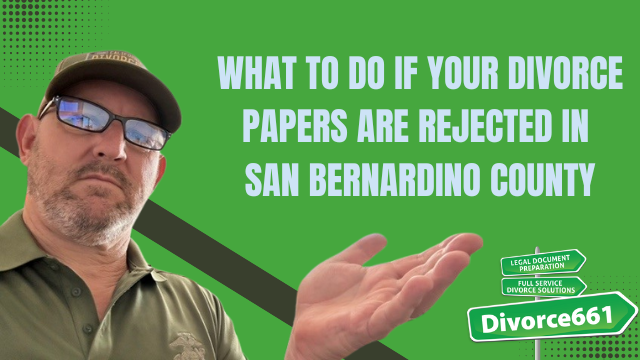How to Finalize a Divorce in San Bernardino County in 6 Weeks
I’m Tim Blankenship with Divorce661. In this post I’ll walk you through how you can complete your San Bernardino County divorce paperwork and get court approval as quickly as the law allows — often in as little as six weeks. California law includes a mandatory six-month waiting period, but that doesn’t mean you must wait six months to finish everything. Here’s a clear, step-by-step guide to moving your divorce forward fast and efficiently.
How California’s 6-Month Rule Actually Works
California requires a minimum six-month waiting period from the date your spouse is properly served before a divorce can be finalized. That six months is a hard statutory timeline — the divorce won’t officially become final until then. However, the statute does not prevent you from completing and submitting all necessary paperwork well before that date.
The critical point is this: once the petition is filed and your spouse is properly served, the six-month clock starts. But during that countdown you can do everything else — disclosures, negotiation, and filing the final judgment package — so the court can review and approve your agreement long before the six months expire.
Step-by-Step: How to Get Court Approval Fast
- File the petition: Start the process by filing the divorce petition with the court.
- Serve your spouse: Ensure your spouse is properly served. The six-month waiting period begins on the date of service.
- Complete financial disclosures: Exchange required financial documents (income, assets, debts). Full, accurate disclosures are essential to avoid delays.
- Draft and sign a marital settlement agreement: Reach agreement on property division, debts, support, and other issues, then sign the marital settlement agreement.
- Prepare and submit the final judgment package: Assemble the judgment packet, including the signed agreement and required court forms, and submit it to the court for approval.
- Court review: If everything is complete and both parties are in agreement, the court will review and often approve the paperwork within a few weeks.
Real Client Example
“We recently helped a San Bernardino couple file, complete disclosures, and submit their judgment package, all in under 30 days. The court approved their paperwork in week six. Now they just wait for the six-month date for the divorce to finalize automatically. No further action needed.”
This example shows how quickly the administrative portion of a divorce can move when both parties are cooperative and the paperwork is complete and accurate. After court approval, the case simply sits until the six-month statutory date, at which time the divorce becomes final without additional filings.
What We Handle at Divorce661
- Fast, flat-fee divorce services designed for amicable cases
- 100% remote handling through the court’s eFile system
- Filing the petition and other court forms
- Service coordination
- Preparing and exchanging financial disclosures
- Drafting marital settlement agreements
- Preparing and submitting the final judgment package
Typical Timeline — From Filing to Court Approval
If everything is in agreement and properly completed, here’s a realistic timeline you can expect:
- Days 0–7: File petition and arrange service
- Days 7–30: Exchange disclosures, negotiate and sign settlement agreement
- Days 20–40: Prepare and submit judgment package to court (via eFile)
- Weeks 4–6: Court reviews and often approves the paperwork
- Six months from service date: Divorce automatically finalizes
Key Things to Know
- Service matters: The six-month clock starts only after proper service — make sure service is done correctly and documented.
- Complete disclosures: Full and accurate financial disclosures reduce the chance of the court asking for more information or rejecting papers.
- Agreement speeds things up: If both parties agree on terms, courts are typically able to approve the judgment packet quickly.
- Approval ≠ finality: Court approval of your agreement does not bypass the statutory six-month waiting period — it only means the paperwork is ready to become final when the date arrives.
Is This Right for You?
Fast timelines work best for amicable divorces where both parties are willing to cooperate and exchange required information. If your case involves complex property disputes, contested issues, or disagreements over disclosures, the process will likely take longer.
Conclusion — Move Forward, Faster
You don’t have to wait passively for six months to end your marriage in California. By organizing paperwork, completing disclosures, and submitting a polished final judgment package, you can obtain court approval well before the statutory finalization date — often within six weeks. At Divorce661 we specialize in doing exactly that: fast, flat-fee, court-friendly divorces handled remotely through eFile so you can move on with your life without unnecessary delay.
Interested in a free consultation? Visit divorce661.com to schedule a call and learn how we can help finalize your San Bernardino divorce as quickly as the law allows.



